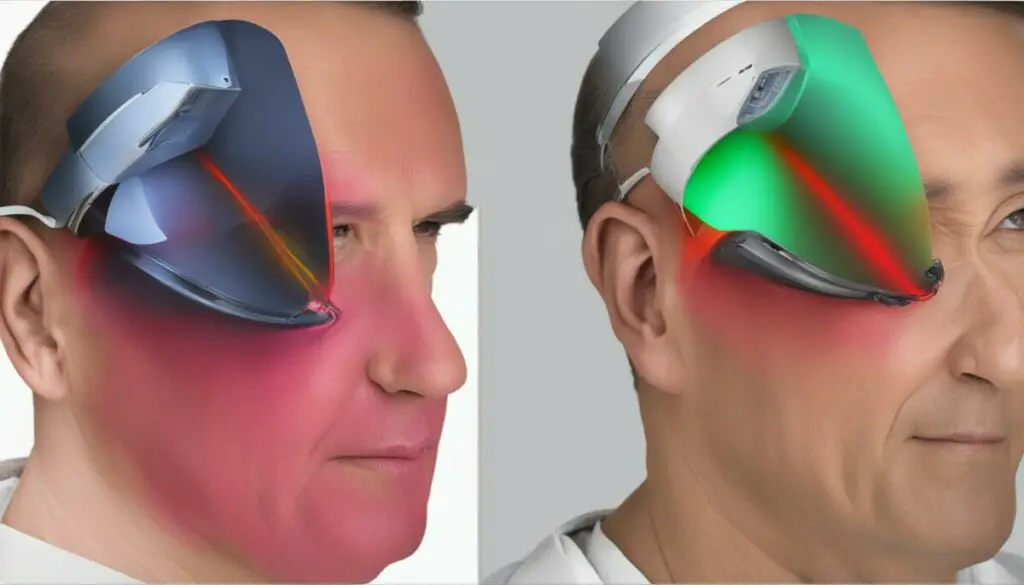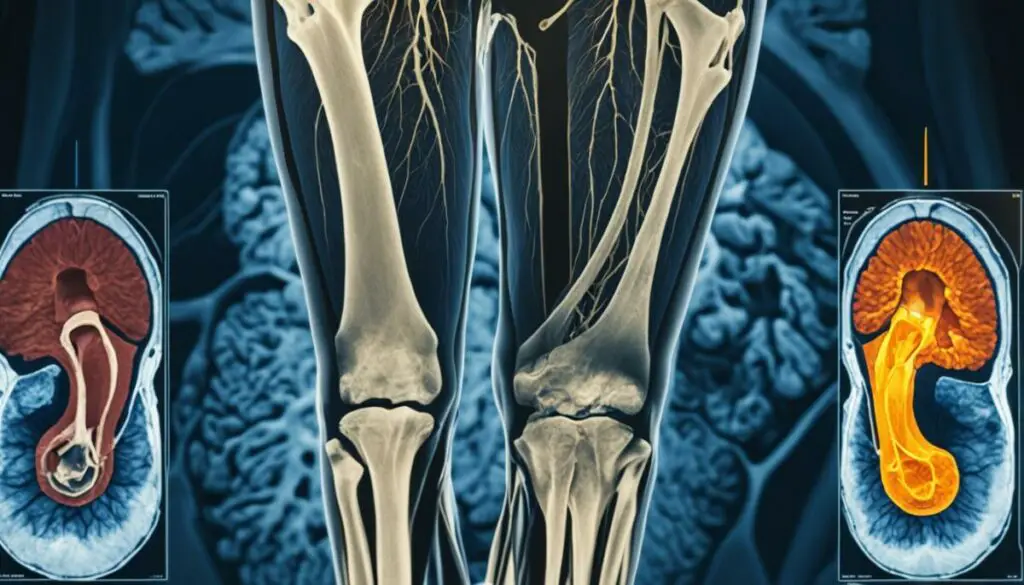Last Updated on 4 months by Francis
Lipomas are common benign mesenchymal tumors that can develop anywhere in the body. While surgery is the most common treatment for lipomas, there are non-surgical options available, such as the use of far infrared radiation. Far infrared radiation therapy has been studied for its potential therapeutic effects on lipomas, offering a natural and non-invasive alternative to surgery.
In this article, we will explore the role of far infrared radiation in lipoma reduction and its benefits as a non-surgical treatment option. We will also discuss other natural remedies and surgical options for lipoma removal. Additionally, we will delve into the importance of magnetic resonance imaging (MRI) in the evaluation of lipomas and examine the current research on the use of far infrared radiation for lipoma reduction.
Contents
Key Takeaways:
- Far infrared radiation offers a non-invasive and natural treatment option for lipoma reduction.
- It can effectively reduce the size of lipomas with minimal adverse effects.
- Other natural remedies, such as essential oils and dietary changes, can also be considered for lipoma reduction.
- Surgical options, including excision, liposuction, and laser-assisted lipolysis, are available for lipoma removal.
- Magnetic resonance imaging (MRI) plays a crucial role in the evaluation and monitoring of lipomas.
Understanding Lipomas: Causes and Characteristics

Lipomas are benign tumors that consist of adipose tissue. They can develop anywhere in the body and are usually painless. The exact cause of lipomas is unknown, but they are believed to be caused by an overgrowth of fat cells. Lipomas are typically soft, movable, and have a rubbery texture. They can vary in size, ranging from a few millimeters to several centimeters.
While surgery is the most common treatment for lipomas, there are non-surgical options available, such as high-intensity focused ultrasound (HIFU), which has been shown to reduce lipoma size noninvasively.
Lipoma Characteristics:
- Consist of adipose tissue
- Typically soft, movable, and have a rubbery texture
- Vary in size, ranging from a few millimeters to several centimeters
HIFU has emerged as an effective non-surgical lipoma reduction technique, offering patients a minimally invasive alternative to surgery.
By utilizing high-intensity sound waves, HIFU specifically targets and destroys the fat cells within the lipoma without the need for incisions or anesthesia. This non-surgical approach to lipoma treatment has gained popularity due to its effectiveness in reducing lipoma size and minimal downtime for patients.
It is important to note that the suitability of HIFU and other non-surgical lipoma treatment options may vary depending on the size, location, and characteristics of the lipoma. Consulting with a healthcare professional is essential to determine the most suitable treatment plan.
The Role of Far Infrared Radiation in Lipoma Reduction

Far infrared radiation has been extensively studied for its potential therapeutic effects on various health conditions, including lipoma reduction. This non-invasive treatment modality involves the use of infrared therapy to target lipomas and promote shrinkage.
Infrared therapy works by increasing blood flow and improving circulation, which can help reduce the size of lipomas. The far infrared radiation penetrates deep into the skin, reaching the adipose tissue where lipomas form. By applying far infrared radiation to lipomas, the heat generated can break down the fatty tissues and stimulate lipoma shrinkage.
This natural and non-invasive approach offers an alternative option for lipoma treatment, especially for individuals who prefer to avoid surgery. The therapeutic benefits of far infrared radiation therapy extend beyond lipoma reduction, as it also improves blood circulation, aids in detoxification, and provides pain relief.
Further research is being conducted to explore the efficacy and optimal parameters of far infrared radiation therapy for lipoma reduction. These studies aim to provide a better understanding of the mechanisms involved and to enhance the effectiveness of this non-surgical treatment method.
| Benefits of Far Infrared Radiation Therapy for Lipoma Reduction |
|---|
| 1. Stimulates lipoma shrinkage through the breakdown of fatty tissues. |
| 2. Improves blood circulation and enhances lymphatic drainage, aiding in the elimination of toxins. |
| 3. Provides pain relief for individuals with lipomas. |
| 4. Non-invasive and natural treatment option, avoiding the need for surgery. |
| 5. Can be applied to specific areas affected by lipomas, allowing for targeted treatment. |
As research on far infrared radiation therapy for lipoma reduction progresses, it holds promise as a safe and effective non-surgical treatment option. However, it is important to consult with a healthcare professional to determine the suitability of this therapy for individual cases and to discuss the potential benefits and risks.
Benefits of Infrared Therapy for Lipoma Reduction

Infrared therapy offers several benefits for lipoma reduction. First, it is a non-invasive treatment option, which means that it does not require surgery and is generally well-tolerated. Second, infrared therapy can target specific areas affected by lipomas, allowing for precise treatment. Third, infrared therapy promotes blood circulation and lymphatic drainage, which can help eliminate toxins and reduce inflammation associated with lipomas. Additionally, infrared therapy has been shown to have analgesic effects, providing pain relief for individuals with lipomas. Overall, infrared therapy offers a safe and effective approach to reducing lipoma size.
| Benefits of Infrared Therapy for Lipoma Reduction |
|---|
| Non-invasive treatment option |
| Precise targeting of lipoma-affected areas |
| Improves blood circulation and lymphatic drainage |
| Reduces inflammation associated with lipomas |
| Provides analgesic effects for pain relief |
Other Natural Remedies for Lipoma Reduction

In addition to infrared therapy, there are other natural remedies that have been suggested for lipoma reduction. Some individuals have reported success with topical applications of certain essential oils, such as frankincense, myrrh, and oregano oil. These essential oils are believed to have anti-inflammatory and antioxidant properties, which can help reduce the size of lipomas.
Other natural remedies include dietary changes, such as reducing processed foods and increasing the consumption of fruits and vegetables, as well as the use of herbal supplements like turmeric and green tea extract. These natural remedies offer alternative options for individuals seeking non-surgical approaches to lipoma reduction.
Topical Application of Essential Oils
Several essential oils have been suggested for reducing lipoma size when applied topically. These include frankincense, myrrh, and oregano oil. These essential oils have anti-inflammatory and antioxidant properties, which are believed to help shrink lipomas. To use these oils, apply a few drops to the affected area and gently massage it into the skin. Repeat this process a few times a day for optimal results.
Dietary Changes
Making dietary changes can also support lipoma reduction. Reduce the consumption of processed foods, which are often high in unhealthy fats and additives. Instead, focus on a diet rich in fruits and vegetables, which provide essential nutrients and antioxidants that support overall health and well-being. Additionally, staying hydrated and avoiding excessive alcohol consumption may also be beneficial for lipoma reduction.
Herbal Supplements
Herbal supplements like turmeric and green tea extract have been suggested to help reduce lipoma size. Turmeric contains the active compound curcumin, which has anti-inflammatory properties. Green tea extract is rich in antioxidants and may help promote fat metabolism. However, it’s important to consult with a healthcare professional before incorporating any new supplements into your routine to ensure they are safe and appropriate for your individual needs.
While these natural remedies may not work for everyone, they offer additional options to consider for individuals seeking non-surgical approaches to lipoma reduction. It’s important to remember that natural remedies should be used as complementary treatments and should not replace medical advice or prescribed treatments. Always consult with a healthcare professional for proper diagnosis and guidance.
Surgical Options for Lipoma Removal

Surgery is a common and effective treatment for lipomas, especially when they cause pain, discomfort, or cosmetic concerns. There are different surgical options available for lipoma removal, depending on various factors such as the size and location of the lipoma and individual preferences.
Traditional Excision
One surgical option is traditional excision, which involves cutting out the lipoma and closing the incision with stitches. This is a straightforward procedure that can be performed under local anesthesia. Traditional excision is suitable for lipomas that are easily accessible and not too large.
Liposuction
Liposuction is another surgical technique used for lipoma removal. It involves using a suction device to remove the fatty tissue through a small incision. Liposuction is often preferred for larger lipomas or those located in areas where excision may not be practical, such as the neck or face.
Laser-Assisted Lipolysis
Laser-assisted lipolysis is a minimally invasive surgical procedure that utilizes laser energy to break down the lipoma before it is removed. This technique offers precise targeting and minimal scarring. Laser-assisted lipolysis may be a suitable option for lipomas that are difficult to access or require more specialized treatment.
Overall, the choice of surgical option depends on the characteristics of the lipoma and the preferences of the individual. It is important to consult with a qualified healthcare professional to determine the most appropriate surgical approach for lipoma removal.
The Potential of Non-Surgical Lipoma Treatment

Non-surgical lipoma treatment options are gaining popularity as they offer a less invasive alternative to traditional surgery. In addition to high-intensity focused ultrasound (HIFU) and infrared therapy, there are other non-surgical options that can effectively reduce lipomas.
Cryotherapy: Cryotherapy involves freezing the lipoma to destroy the fatty tissue. This non-surgical method is particularly suitable for smaller lipomas that are not causing significant symptoms.
Steroid Injections: Steroid injections can help reduce inflammation and shrink lipomas. This treatment option is often recommended for individuals who are unable or unwilling to undergo surgery.
It is important to consult with a healthcare professional to determine the most appropriate non-surgical treatment option for individual cases. They can evaluate the size and characteristics of the lipoma and recommend the most suitable approach.
Benefits of Non-Surgical Lipoma Treatment:
- Less invasive than surgery
- No scarring
- Potential for quick recovery
- Minimal discomfort
- Lower risk of complications
Non-surgical lipoma treatment offers a viable alternative for individuals who prefer a less invasive approach or have lipomas that do not require surgical removal. However, it is important to note that the effectiveness of non-surgical treatments may vary depending on the size and location of the lipoma. Therefore, it is crucial to consult a healthcare professional for personalized advice and treatment planning.
“Non-surgical lipoma treatment offers a less invasive alternative to traditional surgery, allowing individuals to avoid scarring and experience a potentially quicker recovery.”
The Role of Magnetic Resonance Imaging in Lipoma Evaluation

Magnetic resonance imaging (MRI) plays a crucial role in the evaluation of lipomas. MRI allows for detailed visualization of lipomas, providing information about their size, location, and characteristics. This imaging technique uses powerful magnets and radio waves to create detailed images of the soft tissues in the body.
When it comes to lipoma evaluation, MRI is particularly valuable due to its ability to differentiate lipomas from other soft tissue masses, such as cysts or malignant tumors. This is essential for accurate diagnosis and subsequent treatment planning.
MRI can provide a wealth of information about the lipoma, including its location within the body and its proximity to vital structures. This information is crucial in determining the best course of action for treatment.
Additionally, MRI can be used to monitor the effectiveness of non-surgical treatments, such as high-intensity focused ultrasound (HIFU), by assessing changes in lipoma size over time. This allows healthcare professionals to adjust treatment plans as necessary and evaluate the success of the chosen approach.
In summary, MRI is a valuable tool in the diagnosis and management of lipomas. Its ability to provide detailed images of lipomas and differentiate them from other masses makes it an essential tool for healthcare professionals in the evaluation and treatment of lipomas.
| Advantages of MRI in Lipoma Evaluation | Disadvantages of MRI in Lipoma Evaluation |
|---|---|
| Accurate visualization of lipoma size, location, and characteristics | Requires specialized equipment and expertise |
| Differentiation of lipomas from other soft tissue masses | Potential for claustrophobia and discomfort during the procedure |
| Non-invasive and painless imaging technique | MRI may not be suitable for individuals with certain medical conditions, such as severe kidney problems or metallic implants |
Research on Far Infrared Radiation and Lipoma Reduction
Ongoing research is being conducted to explore the potential of far infrared radiation for lipoma reduction. Numerous studies have shown promising results, demonstrating that far infrared radiation can effectively reduce the size of lipomas, leading to significant volume reductions.
Researchers are delving into the underlying mechanisms of how far infrared radiation influences lipoma growth and shrinkage. By gaining a deeper understanding of these processes, they hope to optimize the delivery of far infrared radiation for maximum effectiveness. This includes investigating factors such as the intensity and duration of treatment sessions, which can greatly impact the outcomes.
These research findings are invaluable in expanding our knowledge of non-invasive lipoma treatment options. They contribute to the growing body of evidence supporting the use of far infrared radiation as a safe and effective treatment modality for lipoma reduction.
Current Studies on Far Infrared Radiation and Lipoma Reduction
1. Study Title: Investigating the Efficacy of Far Infrared Radiation Therapy for Lipoma Reduction
“We aim to evaluate the effectiveness of far infrared radiation therapy in reducing lipoma size and to determine the optimal parameters for treatment. Our study involves a controlled clinical trial with a diverse group of participants. By analyzing the outcomes, we hope to provide valuable insights into the application of far infrared radiation for lipoma reduction.”
2. Study Title: Mechanisms of Action of Far Infrared Radiation on Lipoma Growth
“Our study aims to elucidate the molecular mechanisms underlying the effects of far infrared radiation on lipoma growth and development. We will investigate changes in gene expression, adipocyte metabolism, and inflammatory pathways before and after treatment. This research will contribute to a better understanding of the therapeutic potential of far infrared radiation for lipoma reduction.”
3. Study Title: Optimizing the Parameters for Far Infrared Radiation Treatment of Lipomas
“Through this study, we aim to identify the optimal parameters for delivering far infrared radiation to achieve maximum lipoma reduction. We will investigate the effects of different intensities, treatment durations, and frequencies on lipoma size and morphology. The results will inform the development of tailored treatment protocols for far infrared radiation therapy.”
| Study | Research Objective | Expected Outcomes |
|---|---|---|
| Investigating the Efficacy of Far Infrared Radiation Therapy for Lipoma Reduction | Evaluate the effectiveness of far infrared radiation therapy for lipoma reduction. | Provide insights into the application of far infrared radiation for lipoma reduction. |
| Mechanisms of Action of Far Infrared Radiation on Lipoma Growth | Elucidate the molecular mechanisms underlying the effects of far infrared radiation on lipoma growth. | Contribute to a better understanding of the therapeutic potential of far infrared radiation for lipoma reduction. |
| Optimizing the Parameters for Far Infrared Radiation Treatment of Lipomas | Identify the optimal parameters for delivering far infrared radiation in lipoma treatment. | Inform the development of tailored treatment protocols for far infrared radiation therapy. |
These ongoing studies are paving the way for advancements in non-invasive lipoma treatment options. They provide crucial insights into the benefits and applications of far infrared radiation therapy, establishing its role as a potential alternative to surgical interventions for lipoma reduction.
Conclusion
In conclusion, far infrared radiation shows promise as a non-invasive and natural treatment option for lipoma reduction. It has been shown to effectively reduce the size of lipomas, with minimal adverse effects.
Infrared therapy offers several benefits for lipoma treatment. It improves blood circulation, which can help deliver essential nutrients and oxygen to the affected area, promoting healing. Additionally, infrared therapy enhances lymphatic drainage, aiding in the removal of toxins and waste products from the body. The analgesic effects of infrared therapy provide relief from pain and discomfort associated with lipomas.
While far infrared radiation is a promising treatment option, it’s essential to consider individual preferences and the characteristics of the lipoma. Other natural remedies, such as topical application of essential oils and dietary changes, may complement the effects of infrared therapy. In some cases, surgical options like excision or liposuction may be necessary, especially for larger or symptomatic lipomas.
Magnetic resonance imaging (MRI) plays a crucial role in the evaluation and monitoring of lipomas. It provides detailed information about the size, location, and characteristics of lipomas, assisting in accurate diagnosis and treatment planning. By tracking changes in lipoma size over time, MRI helps assess the effectiveness of non-surgical approaches like infrared therapy.
As research on the use of far infrared radiation for lipoma reduction continues, it contributes to the advancement of non-surgical approaches to lipoma management. With its potential to provide safe and effective results, far infrared radiation offers hope for individuals seeking alternatives to traditional surgery in their lipoma treatment journeys.
FAQ
Can far infrared radiation reduce lipoma size?
Far infrared radiation therapy has been studied for its potential therapeutic effects on lipoma reduction. It works by increasing blood flow and improving circulation, which can help reduce the size of lipomas. Infrared therapy has been shown to penetrate deep into the skin, reaching the adipose tissue where lipomas form. By applying far infrared radiation to lipomas, it is believed that the heat generated can break down the fatty tissues and promote lipoma shrinkage.
What are some natural remedies for lipoma reduction?
In addition to far infrared radiation therapy, there are other natural remedies that have been suggested for lipoma reduction. Some individuals have reported success with topical applications of certain essential oils, such as frankincense, myrrh, and oregano oil, which have anti-inflammatory and antioxidant properties. Other natural remedies include dietary changes, such as reducing processed foods and increasing the consumption of fruits and vegetables, as well as the use of herbal supplements like turmeric and green tea extract.
What are the surgical options for lipoma removal?
The most common treatment for lipomas is surgery, especially when they are causing pain, discomfort, or aesthetic concerns. The surgical options for lipoma removal include traditional excision, liposuction, and laser-assisted lipolysis. Excision involves cutting out the lipoma and closing the incision with stitches. Liposuction uses a suction device to remove the fatty tissue through a small incision. Laser-assisted lipolysis involves using laser energy to break down the lipoma before removal. The choice of surgical option depends on various factors, including the size and location of the lipoma, as well as the individual’s preferences.
What are the benefits of infrared therapy for lipoma reduction?
Infrared therapy offers several benefits for lipoma reduction. Firstly, it is a non-invasive treatment option that does not require surgery and is generally well-tolerated. Secondly, infrared therapy can target specific areas affected by lipomas, allowing for precise treatment. Thirdly, it promotes blood circulation and lymphatic drainage, which can help eliminate toxins and reduce inflammation associated with lipomas. Additionally, infrared therapy has been shown to have analgesic effects, providing pain relief for individuals with lipomas.
Are there other options for non-surgical lipoma treatment?
Yes, besides far infrared radiation therapy, there are other non-surgical options for lipoma treatment. These include cryotherapy, which involves freezing the lipoma to destroy the fatty tissue, and steroid injections, which can help reduce inflammation and shrink the lipoma. These non-surgical treatments may be more suitable for individuals who are unable or unwilling to undergo surgery, or for lipomas that are small and not causing significant symptoms. It is important to consult with a healthcare professional to determine the most appropriate treatment option for individual cases.









